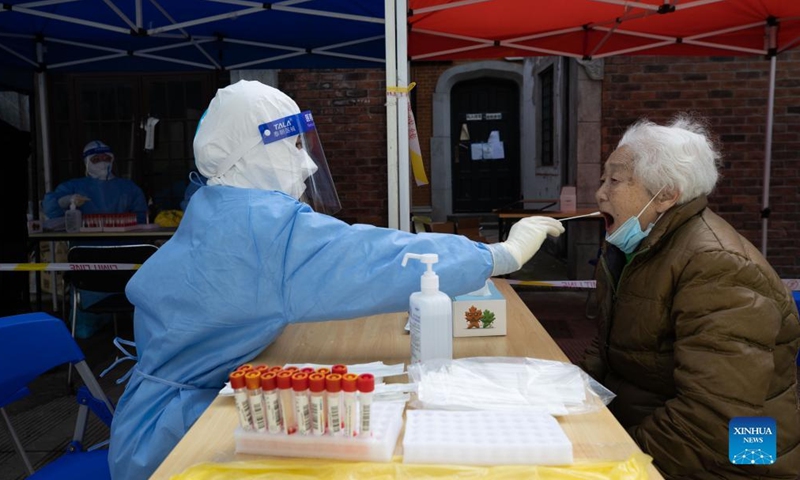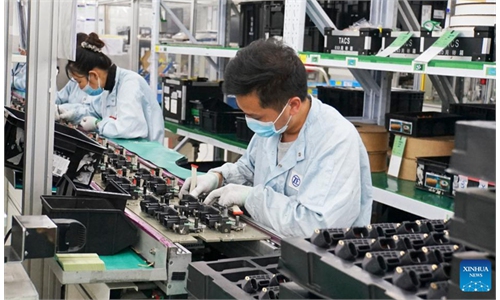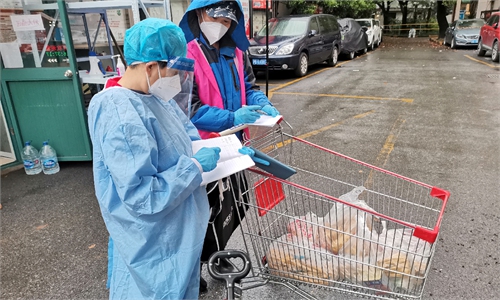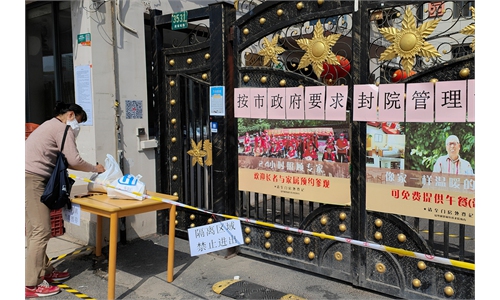
A medical worker takes a swab sample from a woman for nucleic acid test in Changning District of east China's Shanghai, April 1, 2022. Shanghai has launched a nucleic acid testing campaign in areas west of the Huangpu River from Friday amid the second phase of the city's closed-off management.Photo:Xinhua
The proportion of people with COVID-19 found in at-risk groups is declining in the Omicron variant hard-hit city of Shanghai, where there are 16 patients in severe condition at present, Shanghai health authorities announced on Sunday.
Among the severe patients who are receiving medical treatment, the youngest is 33 years old and the rest are aged above 70. It is noteworthy that among the 16 patients, only one had been fully vaccinated and none of the rest had done so due to their severe underlying medical conditions.
Shanghai's new daily tally remained high with 3,238 confirmed cases and 21,582 asymptomatic infections being registered on Saturday. However, since 1,177 confirmed cases were previously reported as asymptomatic cases, the actual number of newly confirmed cases was 2,061, according to the local health authority.
With only 307 confirmed cases and 415 asymptomatic infections being found among people with COVID-19 in at-risk groups, the proportion is declining, Wu Jinglei, director of Shanghai Municipal Health Commission, said during a press briefing on Sunday. Also, according to Wu, newly found positive infections of the COVID-19 remained high but relatively stable overall.
Shanghai will adhere to the dynamic zero-COVID policy and spare no efforts in eliminating infections in communities through mass nucleic acid testing, supplemented by antigen screening in key areas, trying to achieve the goal of zero cases in the shortest time, Wu said, noting that the "locked down," "controlled" or "precautionary" compounds would be dynamically adjusted based on phased screening results.
On Friday, Chinese Vice Premier Sun Chunlan said that the city's fight against the epidemic had achieved phased results, with the Rt transmission number falling to 1.23 from 2.27, meaning the goal of zero-cases in communities is within reach.
Wang Guangfa, a respiratory expert at Peking University First Hospital, pointed out that the falling Rt transmission number showed that the spread of the epidemic has slowed and the measures to contain the epidemic have taken effect, but it is noteworthy that there might still exist loopholes in epidemic prevention.
Compared with positive tests found among people at risk, more attention should be given to people confined in their communities, Wang told the Global Times on Sunday.
Wu detailed the condition of the 33-year-old patient in severe condition, who has severe autoimmune diseases and is suffering from an obvious immune function decline. According to Wu, the patient relies on hemodialysis since the patient's kidneys do not function well. When the patient was hospitalized, the patient suffered from lesions in the lungs and pericardial effusion.
The condition of the patient's lungs has improved after anti-virus treatments together with traditional Chinese medicine (TCM), and the underlying diseases and autoimmune diseases are being treated.
Apart from this patient, others have severe underlying diseases including diabetes, cardiovascular and cerebrovascular diseases, malignant tumors, pulmonary embolisms or chronic obstructive pulmonary disease.
For these patients, the health authority has allocated more medical resources to treat them with multidisciplinary consultation and joint treatment to target their severe underlying diseases in particular.
Pneumonia caused by the COVID-19 virus is being treated with a combination of micro-molecular medicines and TCM, to which increased oxygen supply, or ventilators and ECMO may be added as a complementary advantage to speed up the recovery process.
Since these elderly patients are not vaccinated, Wu urged the local elderly population to get vaccinated as soon as possible after the lockdown is lifted.
As of Friday, nearly 3.6 million Shanghai residents aged 60 or above had completed their vaccination programs, accounting for 62 percent of the elderly population, noted Wu.
Wu said that the Omicron variant poses great hazards to the elderly, especially those who have not been vaccinated and have chronic underlying diseases. Although vaccination does not completely stop the transmission of the virus, it is highly effective in preventing severe illness and death.
In general, people with chronic diseases who take medicines regularly and are not experiencing an acute episode, or whose conditions are well controlled and stable, can be vaccinated, experts said.
According to Wu, a total of 373 confirmed patients had been discharged from hospitals and 10,337 of those with asymptomatic infections have been released from centralized medical observation venues as of Saturday. They returned to their residences and their health conditions will continue to be monitored.



